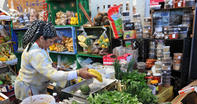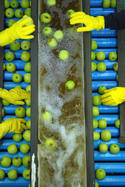Food Security Defined
The United Nations Food and Agriculture Organization (FAO) definition states that food security occurs when 'all people, at all times, have physical, social and economic access to sufficient, safe and nutritious food that meets their dietary needs and food preferences for an active and healthy life'.

But this definition does not consider how people get their hands on this food. So the concept got fleshed out a bit more, suggesting that food security is also about the right to food, which should, at the very least include 'an available, adequate, dependable and sustainable food supply and an assured ability to acquire nutritious and culturally acceptable foods through normal food distribution channels'.
Put simply, food security is about people being able to get their hands on safe, wholesome food that meets their body's dietary needs and which matches their palate or cultural preferences, and being able to have ongoing access to that kind of food, today, tomorrow, next month, next year.
Examined in Terms of Context
Looking at it this way, a family is not food secure if it exists in a context where, even though there is plenty of food down at the local market, they do not have money to buy it. If a family lives in a context where prostitution or begging is frowned upon, and the family's mother is forced to barter sex in exchange for money, or beg at traffic lights so they can buy food, is that family food secure?
It doesn't matter how many heads of broccoli are being cut out in the fields of the nearest farmlands, how many are making their way to the city's supermarkets and street traders, or how many people are eating it - because that family, in that context, has to engage in socially inappropriate or risky behaviour to get that broccoli, they do not exist in a food secure state.
Similarly, if a family is given a food aid parcel containing sorghum meal and lentils - one of which is culturally foreign for many South Africans who have cured their palates on maize for the past several decades, and who often do not know what to do with lentils - the result is also a shaky food secure state.
There have been several cases of yellow maize being handed out as a form of food aid but to communities who traditionally eat white maize, and see yellow maize as only good for animal feed. The donor buys the yellow maize because it is cheaper and some- times readily available when white maize is in low supply - more bang for their buck, basically - but the result is an insulting form of food aid to the people who need it, and does not necessarily translate into a more food secure community. Food security needs to be examined in terms of national and regional contexts, as well as what it means at a community, household and individual level.
Food Security on a National Level

From the national perspective, food security implies the ability of a country to 'support its population with minimum per capita nutritional standards', writes Professor Demetre Labadarios and others in a 2009 Human Sciences Research Council (HSRC) assessment of food insecurity in South Africa.
How food secure a nation is, is measured according to projected food supplies - the sum of nationally farmed food plus food imports but with the unused foods subtracted from the equation - as well as how nutritious that food is. In other words, national food security is largely about what the commercial farmers harvest each year, since that is where the bulk of our food comes from, as well as how much we import and export, and whether or not we get food aid.
But even this happens within a global context. The nation's farmers are impacted by natural fluctuations in regional weather, by extreme weather events globally (remember what the 2010 fires in Russia did to global wheat prices?), by soil degradation, government land reform policy, other countries' tariff regulations, the price of oil, commodity trading, local market forces … the list goes on.
Forces exerting themselves at this end of the food value chain might well make themselves felt way down at the other end of that chain in the final prices on items lying in that basket of weekly basics in the grocery store.
Food Security on a Community Level
If we burrow down to a community level, though, food security is a totally different animal. Here, it is more about access to food. At this level, it refers to a situation where the people in a community can get hold of 'a safe, culturally acceptable, nutritionally adequate diet through a sustainable food system that maximises community self-reliance and social justice', according to Labadarios.
A community's degree of food security has as much to do with whether it is positioned close enough to shops and informal traders, as it has to do with whether people have enough money to buy the food once they are standing in the checkout queue.
So when we talk about food security at a national or regional level, we are thinking mostly about production and agricultural output. When we zoom in to the community and household level, we are talking about whether or not people can access food, and how they choose to use it once they have it.
By Leonie Joubert